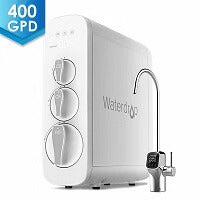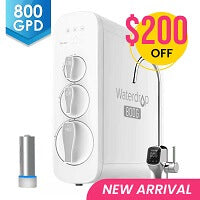Humans cannot survive without water. For a long time, lead-contaminated water has
been known to impact human health adversely. Unfortunately, this contaminant is a leading cause of the water
crisis in the United States.
Before supplying water to households, water utilities test drinking water for lead.
And if
the
lead level exceeds 15 parts per billion (ppb) in over 10% of homes with the supplied water, necessary
action is taken to reduce the presence of the contaminant.
For better water safety, the acceptable lead level in water has been reduced from
15 ppb to 5 ppb, especially for water supplied to schools and licensed child care facilities. Furthermore, lead
testing is mandatory before water is supplied to these facilities.
Why Is Lead a Health Concern?
Lead causes fatal effects in humans. It accumulates in the body after ingestion,
causing various health complications, including increased cancer risk, developmental issues, and damage to the
nervous and reproductive system. Lead accumulation in the body may also increase blood pressure and
anemia and,
in severe cases, may result in death. Unfortunately, the effects of lead poisoning are permanent.
Although there are regulations to minimize lead levels in the water, there is no
safe level of lead exposure. Unfortunately, about 40 million Americans are exposed to lead-contaminated drinking
water at unsafe levels.
How Lead Contaminates Tap Water
Lead is a natural and human-formed substance. Historically, this substance was used
in drinking water distribution systems, paints, and as an additive in gasoline. But, there have been significant
lead reductions in gasoline and paint products. Consequently, food and drinking water are the primary
lead-exposure sources for average adult populations.
Fortunately, several treatment technologies efficiently remove lead at a water
treatment plant. However, municipal treatment is not all that effective in removing lead. The materials used in
the distribution and plumbing system include service lines, solder, and fittings, and these materials may
contain lead. Eventually, the
lead leaches into tap water
through corrosion.
The best approach to minimizing lead exposure from drinking water is to control
corrosion in the water distribution and treatment systems at the municipal level. Investing in a whole-house
water filtration system is the best approach at the house level.
Does Boiling Water Remove Lead?
Unfortunately, boiling does not remove lead in water. Instead, the evaporation
process further concentrates the presence of the contaminant. When using water for cooking or drinking, ensure
it comes from the cold water tap instead of the hot water tap. Heated water in pipes further increases the
release of lead into the water.
Furthermore, if you have not used the water from the pipe in hours, run the cold
water for about a minute or two to flush out the stagnant water before drinking or using it for cooking.
A Reverse Osmosis System - One of the Best Solutions
Using a
reverse
osmosis (RO)
system in your kitchen is one of the most effective
ways to remove lead from the source water. This system eliminates contaminants, including lead, at the point of
use in your house.
A RO system removes the vast majority of lead particulates in water, making it safe
for drinking and cooking in your home. In addition, the system filters out several water contaminants, leaving
you with pure and great-tasting water.
Waterdrop G3 Undersink RO System
The Waterdrop G3 RO system is an undersink system from Waterdrop with multiple
certifications, proving that the system consists of lead-free materials to ensure the safety of both the user
and the filtered water. Furthermore, the Waterdrop G3 RO system has successfully passed over 400 chemical lab
tests, making it the right candidate for safe and healthy water.
Low Drain Ratio
The G3 undersink RO system is different from conventional RO systems. The system is
efficient and produces three times less wastewater, helping you save money on water bills.
Instant Filtered water
The Waterdrop G3 RO system has a design that runs the filtration process on
request. Therefore, you will have to wait only 12 seconds to fill your cup. Furthermore, the machine has a fast
water flow, efficiently delivering 400 gallons of water daily.
NSF 58 and 372 Certifications
The Waterdrop G3 RO system delivers as expected. In addition, the machine has
passed International Certification tests against the NSF/ANSI standards.
Additional Water Filter Kit
The Waterdrop G3 Ro system comes with a kit containing six filters. These filters
include one RO filter, two CB filters, and 3 CF filters. This kit can serve you for two years, saving you money
and time.
Waterdrop 800GPD Reverse Osmosis System with UV Sterilizing Light
Homeowners looking to get a reliable source of RO water in their homes can also
purchase the Waterdrop 800GPD RO system. This system is an upgrade and improvement to the Waterdrop G3.
Consequently, the machine efficiently meets small businesses’ and households’ water needs.
Furthermore, thanks to the advanced filtration technology, you can enjoy pure and
good-tasting water. You can also save 12 times more water courtesy of the system’s inbuilt water-saving
technology.
Efficient Filtration and Improved Materials
The Waterdrop 800GPD has a three-stage filtration process which is efficient. The
filter setup combines with a water scale inhibitor, removing impurities and keeping scales away from your water
appliances. Furthermore, the system has an improved seven-layer RO system for effectively reducing water
contaminants, including heavy metals and chlorine.
Modern and Safer LED UV Sterilizer
The RO system has an advanced LED chip, ensuring the removal of viruses and
bacteria in the source water up to 99.9%. The chip turns on when water passes through and turns off when there
is no passage of water. This mechanism consequently helps to save energy.
Energy-Efficient system with Low-Drain Ratio
The Waterdrop 800GPD RO system efficiently saves water with a 3:1 drain ratio.
Consequently, with this system, you can contribute to keeping the earth safe while lowering your water bill.
Faster Flow with Extended Filtration Capacity
This RO water filter system has an ultra-large filtration capacity of 800 gallons
per day. Therefore, it can adequately meet the needs of a small business or large household. Furthermore, the
system fills a cup in just six seconds. So, you don’t have to wait to get pure water.
Compact and Easy to Install
The tankless RO system has a compact design, requiring only a little installation
space. Consequently, you are not sacrificing all your undersink space. Furthermore, installing and replacing the
system and its components is quite straightforward.
Conclusion
Even after 30 years of being banned, lead pipes still carry water into millions of
homes across the United States. These pipes are tucked underground, and they are more like relics of time past
to most Americans. However, drinking lead-free water is essential for anyone. Drinking any level of lead in
water can harm you and your family.

















































































































